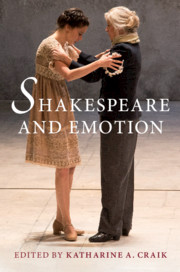Book contents
- Shakespeare and Emotion
- Shakespeare and Emotion
- Copyright page
- Contents
- Figures
- Contributors
- Acknowledgements
- Note on Text
- Introduction
- Part I Contexts
- Chapter 1 Rhetoric
- Chapter 2 Medicine
- Chapter 3 Religion
- Chapter 4 Character
- Chapter 5 Inheritance and Innovation
- Chapter 6 Communities
- Chapter 7 Audiences
- Chapter 8 Acting
- Chapter 9 Bollywood
- Chapter 10 Language
- Chapter 11 Emotional Labour
- Chapter 12 Passionate Shakespeare
- Part II Emotions
- Bibliography
- Index
Chapter 5 - Inheritance and Innovation
Richard III, 3 Henry VI, Richard II, The Merchant of Venice, Timon of Athens
from Part I - Contexts
Published online by Cambridge University Press: 01 October 2020
- Shakespeare and Emotion
- Shakespeare and Emotion
- Copyright page
- Contents
- Figures
- Contributors
- Acknowledgements
- Note on Text
- Introduction
- Part I Contexts
- Chapter 1 Rhetoric
- Chapter 2 Medicine
- Chapter 3 Religion
- Chapter 4 Character
- Chapter 5 Inheritance and Innovation
- Chapter 6 Communities
- Chapter 7 Audiences
- Chapter 8 Acting
- Chapter 9 Bollywood
- Chapter 10 Language
- Chapter 11 Emotional Labour
- Chapter 12 Passionate Shakespeare
- Part II Emotions
- Bibliography
- Index
Summary
This chapter examines the role played by various sources – Shakespeare’s ‘inheritances’ – in shaping the dramatist’s treatments of grief, sorrow and a longing for emotional recognition. I argue that warring characters’ competitive displays of feeling, which are central to the drama of affect in Richard III and 3 Henry VI, derive from but intensify comparable scenes in Senecan drama. However, whilst such competitive emoting is affirmed in these early Shakespearean plays, in Richard II, The Merchant of Venice and elsewhere the same phenomenon – now linked to implicit imitations of Christ’s Passion inspired by the medieval mystery plays – instead provokes scepticism. Having explored this, the chapter then turns to a more contemporary source. I consider, specifically, how early modern ways of conceiving credit relations guided Shakespeare and his co-author, Thomas Middleton, in imagining the emotions in Timon of Athens. Timon too, I contend, affirms himself by parading what he conceives as a kind of love – his credit-funded gestures of charity – in a tacitly competitive fashion. Like earlier Shakespearean characters, though, he is led by this into transmuted reworkings of Christ’s Passion and the latter again expose the compromised, inauthentic nature of emotional display.
- Type
- Chapter
- Information
- Shakespeare and Emotion , pp. 79 - 93Publisher: Cambridge University PressPrint publication year: 2020

